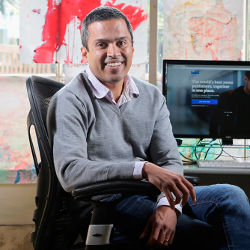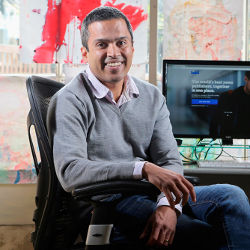
News aggregators are services that pull together online content in one place for ease of viewing on mobile devices. Until recently, the market for news aggregator apps has been dominated by Google, with its Google News & Weather (http://bit.ly/1za0Ycd) for personalized news and weather content, and Google Play Newsstand (http://bit.ly/1IFTeav) for personalized curated content and topic-based collections of articles. Yahoo News Digest (https://mobile.yahoo.com/newsdigest/) has also been popular, as has Apple Newstand (http://apple.co/1TM43uC), which is being revamped into Apple News.
Other notable players include:
- Breaking News (http://www.breakingnews.com/)—Personalized breaking news stories.
- BuzzFeed (www.buzzfeed.com/)—Social content for sharing.
- Facebook Paper (https://www.facebook.com/paper)—An interactive iPhone app that assembles news and other stories.
- Flipboard (https://about.flipboard.com/)—A popular app with user-curated magazines, and 34,000 topics that can be followed.
- Nuzzel (http://nuzzel.com/)—Provides stories popular with users’ friends on Twitter and Facebook.
- Vox Media (www.voxmedia.com)—Available via seven brands/channels: News (Vox.com), Technology and Lifestyle (The Verge), Sports (SB Nation), Gaming (Polygon), Food and Nightlife (Eater), Fashion and Shopping (Racked), and Real Estate and Architecture (Curbed), and many more.
Mobile news also is available via RSS feed services like Feedly, Digg, Latest News & Radion, and GReader.
There also are a number of new players in this arena.
Inkl (www.inkl.com) is an Australian startup, a subscription news service that curates high-quality content from major news outlets using story rankings by the publishers and editors themselves; it achieves a 30% open rate with its daily news email. CEO Gautam Mishra compares Inkl to popular streaming digital media platforms like Netflix, and describes it as the “Spotify of news.” Inkl is not yet available in the U.S., but that could change later this year. A tiered fee structure is planned, with a monthly unlimited-access subscription, a prepaid pay-per-article model, and a free version carrying ads.
SmartNews (www.smartnews.com) describes itself as an “addictively simple news app.” This free download is ranked No. 1 in both Google Play and Apple’s App Store. Downloads have exceeded 10 million, with more than 1 million active users in the U.S. alone, and it now evaluates more than 10 million articles every day. SmartNews has won numerous “App of The Year” and “Best News App” awards. According to CNET, “SmartNews is an excellent free alternative to other popular news apps.”
Co-founder and co-CEO Ken Suzuki developed SmartNews to try to entice Tokyo’s millions of subway commuters away from playing mindless games on their smartphones into reading news stories. Suzuki believes SmartNews’ rivals are not “other news apps,” but “mobile games, social media, and the top apps people use on their smartphones every day. We are competing for the overall attention of the user.” The beta international edition (ultimately covering more than 150 countries and a growing number of local cities) was launched earlier this year.
Despite the decline of newspapers in recent years, Pew Research Center data (http://pewrsr.ch/1OrUDlA) shows consumers continue to have a large appetite for news, though increasingly in digital form. Indeed, digital media has recently overtaken traditional news sources in terms of trust, according to a global survey by Edelman (http://bit.ly/1I6recK). The Pew research showed news is “part of the explosion of social media and mobile devices, and in a way that could offer opportunity to reach more people with news than ever before.”
According to the International News Media Association, “A quarter of the top 20 apps in the news category … are aggregator apps. More and more, publishers are understanding the need to have a presence wherever their readers or potential readers are consuming content” (http://bit.ly/1I6rUij).
Traditional news aggregators always introduce a dilemma to publishers: if users read an article in the app, they will not go to the publisher’s site and the publisher will not make money as a result; yet, this procedure is necessary to reach new audiences. This is an issue highlighted by a report in The New York Times on the substantial decrease of traffic to publishers’ home pages and the subsequent loss of engagement (http://bit.ly/1CB04qM).
Inkl has an unusual approach to this challenge, as users pay for the articles they read, supporting publishers and creating sustainable news. The payback is an ad-free format, which is its main selling point.
SmartNews has its own approach: to get the best publisher content, it created a uniquely publisher-friendly model, ensuring the first click always goes to the publisher’s mobile site, so it is able to keep traffic and related revenue. If the user is offline in the readability mode (SmartView), publishers can place an ad at the bottom of that view and maintain the revenue stream.
These approaches appear to be working, as SmartNews already has over 150 publisher channels (see the full list at http://bit.ly/1aJxEUa/) and Inkl’s global publisher list is also growing.
“Our algorithm is unique in that it is optimized for discovery and diversity, rather than targeted personalization.”
SmartNews senior communications manager Vincent Chang says, “Our machine learning algorithm evaluates 10 million articles and signals a day to uncover the top 20 most interesting and important articles in each category–that matter right now. Our algorithm is unique in that it is optimized for discovery and diversity, instead of targeted personalization. This prevents the ‘filter bubble’ problem (the same topics become boring over time), ensuring you can always find something fresh and interesting each day.”
The SmartNews algorithm looks at more than just social signals and what is trending; it also evaluates many other user behaviors, including whether people finish reading an article, how they share it, and which topics are in the article. The algorithm then uses natural language processing to classify each article into one of the appropriate topic channels (Lifestyle, Business, Sports, Tech, World, U.S., and so on), topics that people are actually reading (not just clicking) and that matter most to them. The algorithm also takes into account what is culturally relevant for each country, as what is trending in one country often differs from what is trending in the next.
SmartNews is designed like a newspaper, a design proven for over a century, with skimmable headlines, minimalist design, and high-quality news content, plus an offline reading mode (SmartView) for times when Internet connectivity is unreliable. The design lets the user see many stories at a glance, and easily find one to read. Looking at the app’s reviews, users appear to be impressed with its interface, usability, intuitiveness, and customizability, and to like the efficient browsing and the smooth swiping between tabs.
Unlike most news aggregators that focus on personalization, SmartNews focuses on discovery. The ethos of the company is about helping users expand their interests and encounter new and fascinating things every day, while connecting them to what others are reading to encourage discussion.
The discovery of news is analogous to variety-seeking buying behavior in marketing; reading articles outside your existing preferences is like switching brands. Variety-seeking is exploration for users, although the risk is that they will experience low satisfaction by trying novel products. SmartNews is designed to introduce users to stories they did not know they wanted to read, rewarding them by widening their horizons without too much additional time cost.
As SmartNews uses state-of-the-art machine learning algorithms instead of human editors to determine which news to capture for its users, the app can evaluate a huge volume of culturally relevant news articles in real time. Chang says, “In the past, this would require building many newsrooms of editors in each country. It allows us to deliver the news much faster and impartially, which is especially important for political news.”
Recommending news through content discovery is a decision-making problem involving uncertainty. In probability theory, this is referred to as the multiarmed bandit problem: a trade-off between the exploration of new possibilities for unknown payoff and the exploitation of known possibilities for an expected payoff. In the context of news aggregator apps, this theory relates to the trade-off between the time invested in reading or searching, and the payoff with quality, relevant, and useful information received.
There are ways to quantify the relationship between exploration/exploitation and risk-taking/avoiding for humans. While at IBM, Ricky Takahashi, one of SmartNews’s data science and machine learning engineers, researched the prediction of consumer choice under uncertainty.
Most news apps use algorithms optimized for personalization—giving us more and more of what we want, with nothing to challenge our beliefs, enlarge our perception, or give us new ideas—which leads to a circular narrowing of knowledge, or a “filter bubble,” a phrase coined by Eli Pariser of Upworthy. In a review of Pariser’s book The Filter Bubble (http://www.thefilterbubble.com), American writer, consultant, and teacher Clay Shirky says, “Internet firms increasingly show us less of the wide world, locating us in the neighborhood of the familiar. The risk, as Eli Pariser shows, is that each of us may unwittingly come to inhabit a ghetto of one.” Indeed, Pew data questions whether the self-selective process, combined with algorithmic feeds, is narrowing the kinds of information to which Americans are exposed.
“What people think they are interested in ahead of time and what they are actually interested in can be completely different.”
SmartNews is unique in that to avoid the trap of personalization and the filter bubble, it optimizes its algorithms for serendipity — those magical “aha” moments when you find something new and amazing, not just things you already follow and know. As Jaroslovsky explains, “what people think they are interested in ahead of time and what they are actually interested in can be completely different.”
In addition to the advanced algorithm, the app uses natural language processing to gain greater understanding of articles by processing the nuance in words. The app lets a user tap into the most interesting and important stories immediately. SmartNews co-founder/co-CEO Kaisei Hamamoto says, “Our machine learning algorithm gets smarter every day, learning from millions of users what stories really matter to humanity—not just what your friends are reading.”
By helping mobile audiences “discover” new articles, SmartNews helps publishers discover new audiences that may not have otherwise found them. The company wants to expand its news discovery algorithm to make it even better at delivering the most culturally relevant and interesting stories tailored to each country.
As the mobile news industry engages new users, novel ways to package news content are being explored; Apple, for example, recently announced a revamped News app as part of iOS 9 that is a little like Flipboard. The competition for the mobile news market is ramping up, which can only be a good thing for consumers and publishers alike.







Join the Discussion (0)
Become a Member or Sign In to Post a Comment